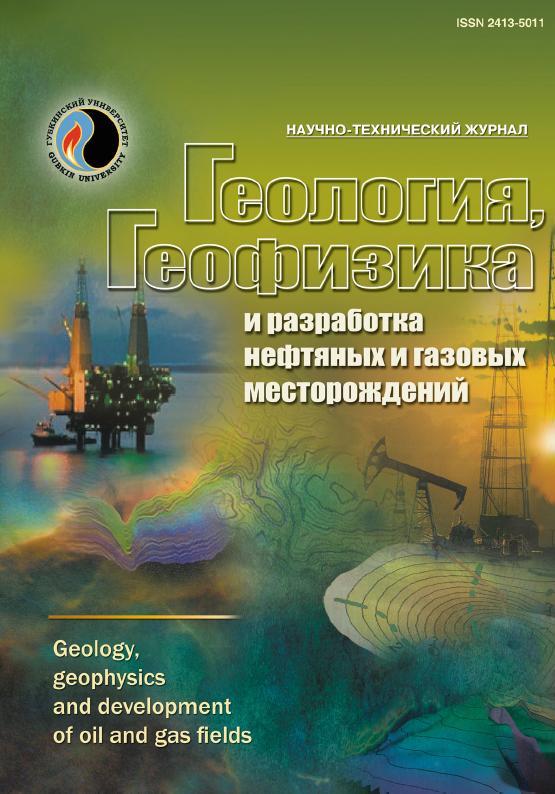Scientific and technical journal
«Geology, geophysics and development of oil and gas fields»
ISSN 2413-5011

Mathematical model for interpretation of hydrodynamic studies data of wells with variable production in a semi-endless strip
UDC: 622.276.031:530.17.001.57
DOI: -
Authors:
1 National University of Oil and Gas "Gubkin University", Moscow, Russia
2 Eurasian Union of Experts on Subsoil Use, Moscow, Russia
Keywords: wells hydrodynamic testing, production analysis, decline curves analysis, well operation history analysis, wells with variable flow-rates, semi-infinite strip model, three-boundary reservoir model
Annotation:
The authors of the article propose a mathematical model for interpreting the hydrodynamic studies data of testing wells with variable flow rates in a homogeneous and isotropic formation in the form of a semi-infinite strip. Otherwise, this interpretation model is called a reservoir model with three impermeable boundaries or a "glass-shaped" boundary model. The proposed mathematical model allows determining the formation permeability, hydraulic conductivity, skin factor, distances to three impermeable boundaries and formation pressure. Some formulas are proposed to describe the bottomhole pressure curve in all possible filtration modes. To describe the curve between modes, a combination of equations describing two adjacent modes is used, thus allowing the best overlay technique to be used for determining the model parameters. Various parameters of the reservoir model are determined in different modes. The proposed model is tested on a real example. The studies of two wells penetrating a carbonate reservoir are considered. A good agreement was obtained between the values of the reservoir parameters using the two considered interpretation methods – the classical approach and the proposed model. The classical approach requires figures of the reservoir pressure and the proposed method allows it to be determined, which is its main advantage.
Bibliography:
1. Robert Erlager ml. Gidrodinamicheskie metody issledovaniya skvazhin. – M.–Izhevsk: Institut komp’yuternykh issledovaniy, 2007. – 512 s.
2. Kul’pin L.G., Myasnikov Yu.A. Gidrodinamicheskie metody issledovaniya neftegazovodonosnykh plastov. – M.: Nedra, 1974. – 200 s.
3. Bourdet D. Well Test Analysis: The Use of Advanced Interpretation Models. – Amsterdam: Elsevier, 2002. – 436 p.
4. Gidrodinamicheskie issledovaniya skvazhin putem ikh puska posle kratkovremennoy ostanovki / S.G. Vol’pin, I.V. Afanaskin, P.V. Kryganov, A.A. Glushakov // Neftepromyslovoe delo. – 2020. – № 11(623). – S. 41–54. – DOI: 10.30713/0207-2351-2020-11(623)-41-54
5. Dynamic Data Analysis V 5.50. / O. Houze, D. Viturat, O.S. Fjaere [et al.]. – Kappa Engineering, 2022. – 778 p.
6. Russell D.G. Determination of Formation Characteristics from Two rate Flow Tests // Jounal of Pet. Tech. – Dec. 1963. – Pp. 1347–1355.
7. Izuchenie svoystv neftyanykh plastov s pomoshch’yu gidrodinamicheskikh issledovaniy skvazhin metodom dvukh rezhimov – teoriya, modelirovanie i praktika / I.V. Afanaskin, P.V. Kryganov, S.G. Vol’pin [i dr.] // Vestnik kibernetiki. – 2015. – № 3(19). – S. 94–116.
8. Gringarten A.C. From Straight Lines to Deconvolution: The Evolution of the State of the Art in Well Test Analysis // SPE Reservoir Evaluation & Engineering. – February 2008. – Pp. 41–62.
9. Ilk D., Valko P.P., Blasingame T.A. A deconvolution Method Based on Cumulative Production for Continuously Measured Flowrate and Pressure Data // SPE 111269. – 2007. – 15 p.
10. Kuchuk F.J., Onur M., Hollaender F. Pressure Transient Formation and Well Testing. Convolution, Deconvolution and Nonlinear Estimation. – Amsterdam: Elsevier, 2010. – 405 p.
11. Multiwell Deconvolution / J.A. Cumming, D.A. Wooff, T. Whittle, A.C. Gringarten // SPE Reservoir Evaluation and Engineering. – November 2014. – Рp. 457–465.
12. Gringarten A.C. New Development in Well Test Analysis. Phase 2. – London: Imperial College, 2018. – 24 p.
13. Zheng Shi-Yi, Wang Fei. Multi-Well Deconvolution Algorithm for the Diagnostic, Analysis of Transient Pressure with Interference from Permanent Down-hole Gauges // SPE 121949. – 2009. – 15 p.
14. Interpretatsiya gidrodinamicheskikh issledovaniy skvazhin bez ostanovki na primere slozhnoy modeli plasta i skvazhiny / P.V. Kryganov, I.V. Afanaskin, S.G. Vol’pin, Yu.B. Chen-len-son // Neftepromyslovoe delo. – 2019. – № 8(608). – S. 45–50. – DOI: 10.30713/0207-2351-2019-8(608)-45-50
15. Kremenetskiy M.I., Ipatov A.I., Gulyaev D.N. Informatsionnoe obespechenie i tekhnologii gidrodinamicheskogo modelirovaniya neftyanykh i gazovykh zalezhey. – M.–Izhevsk: Institut komp’yuternykh issledovaniy, 2012. – 896 s.
16. Analiz dobychi. Kompleksirovanie issledovaniy skvazhin i chislennogo modelirovaniya razrabotki neftyanykh mestorozhdeniy v ramkakh uchebnogo proekta "Tsifrovoe mestorozhdenie" (SurGU – NIISI RAN – RFYaTs) / I.V. Afanaskin, P.V. Kryganov, S.G. Vol’pin, A.A. Egorov // Severnyy region: nauka, obrazovanie, kul’tura. – 2015. – № 2(32). – S. 8–18.
17. Dietz D.N. Determination of Average Reservoir Pressure from Build-Up Surveys // Journal of Pet. Tech.. – Aug. 1965. – Pp. 955–959.
18. Gidrodinamicheskie issledovaniya skvazhin: analiz i interpretatsiya dannykh / T.A. Deeva, M.R. Kamartdinov, T.E. Kulagina [i dr.]. – Tomsk: TsPPS ND TPU, 2009. – 243 s.
19. Afanaskin I.V., Kolevatov A.A., Glushakov A.A. Matematicheskie modeli dlya interpretatsii gidrodinamicheskikh issledovaniy skvazhin s peremennym debitom v plaste s pryamolineynoy nepronitsaemoy granitsey i v plaste s dvumya parallel’nymi nepronitsaemymi granitsami // Neftepromyslovoe delo. – 2023. – № 8(656). – S. 12–17. – DOI: 10.33285/0207-2351-2023-8(656)-12-17